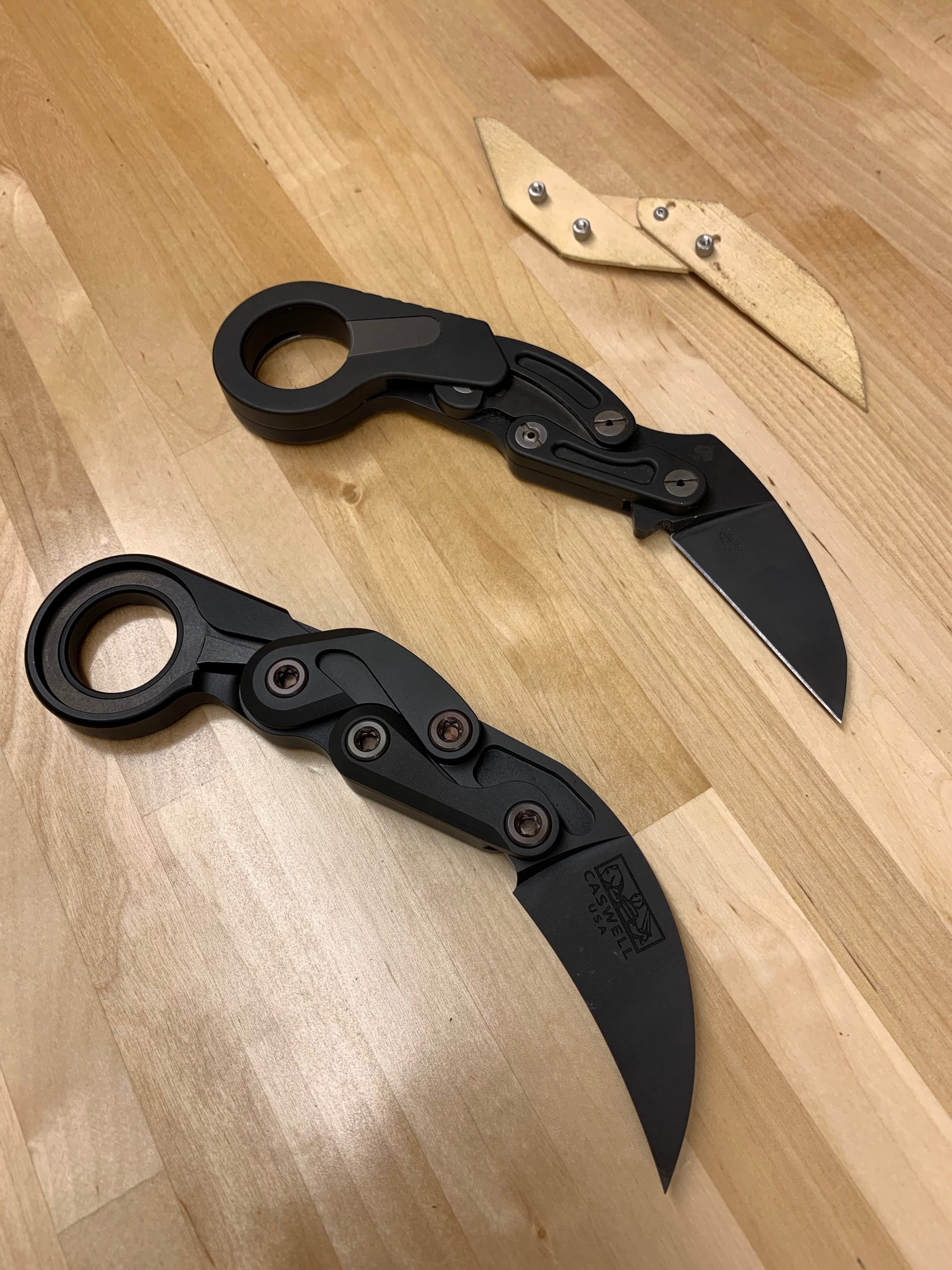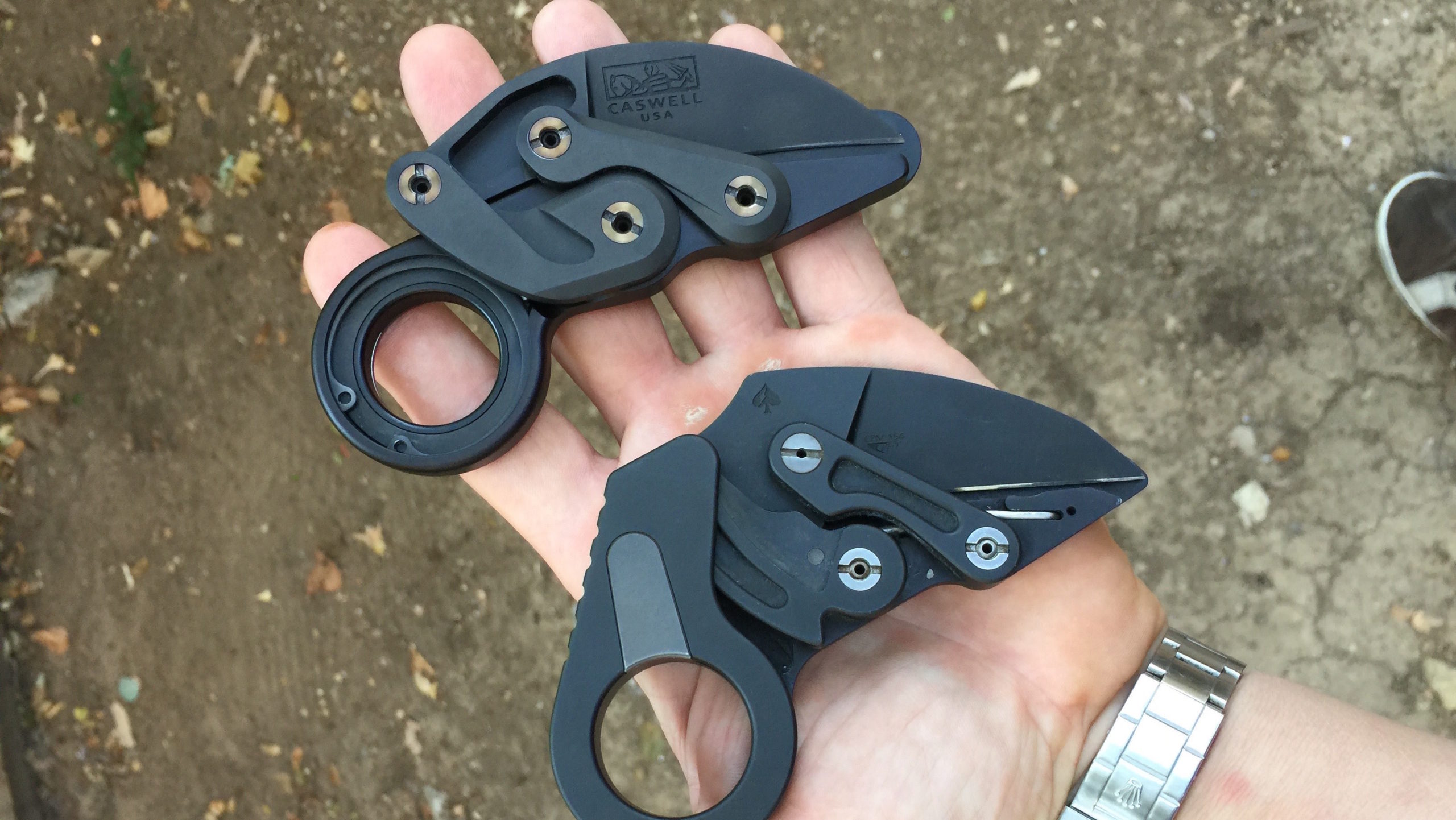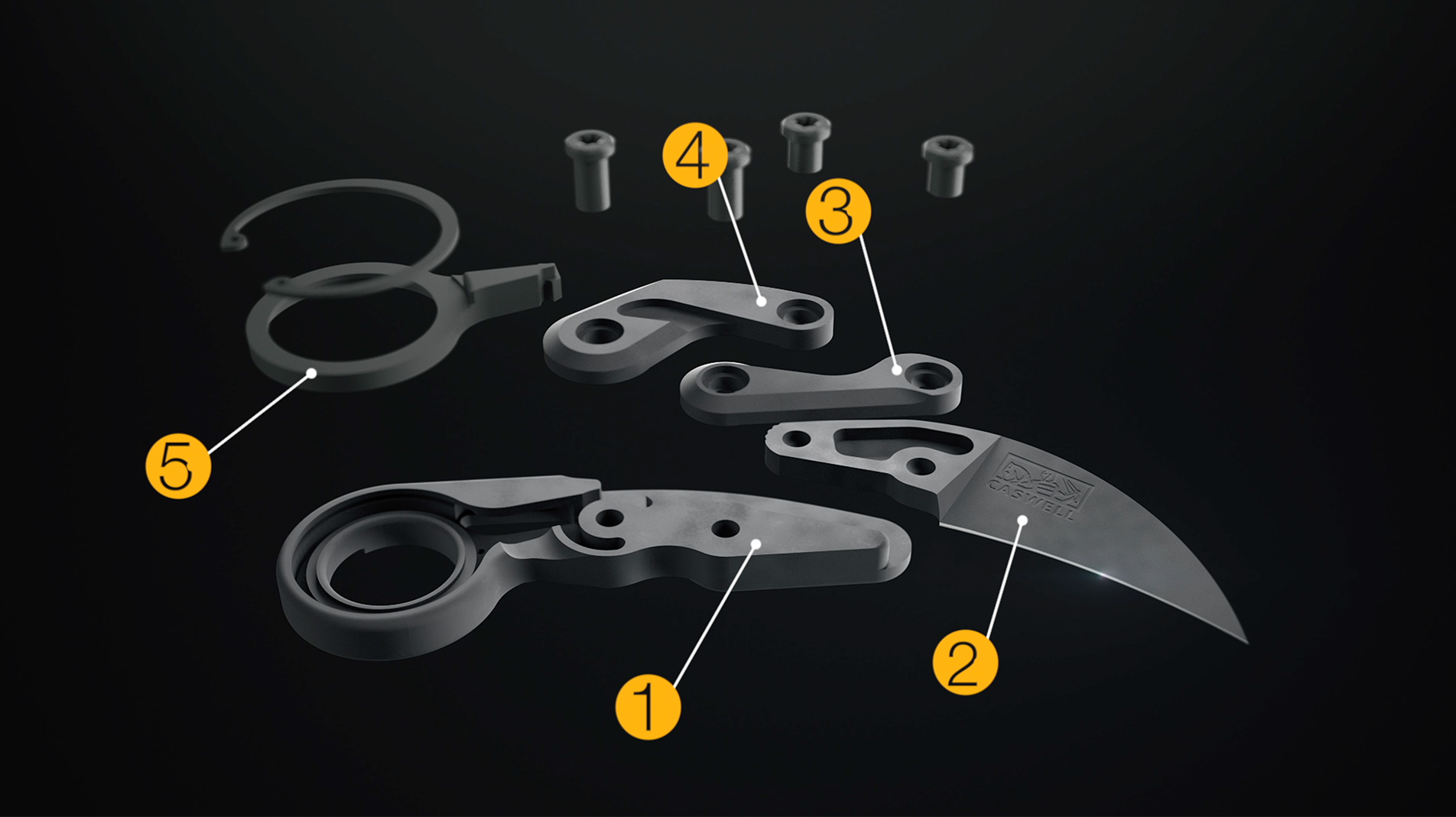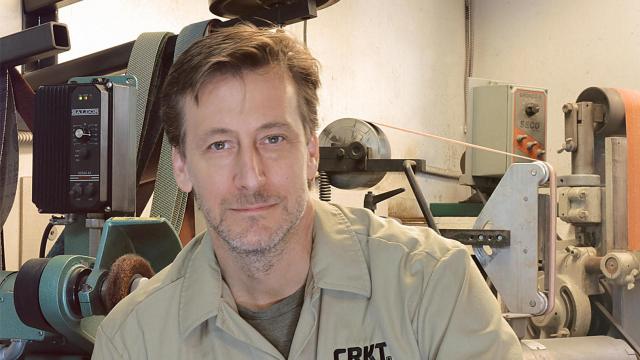Joe Caswell’s knife-making process starts with popsicle sticks, and his latest knife, called the Provoke, looks like something out of a Klingon fever dream. He based the design on an Indonesian karambit, a work knife curved like a talon. His idea? To allow users to flip the utility knife open with one hand using a clever system of hinges and pivots.
The Provoke’s concept is simple: You put a finger through the prominent ring and push the blade forward with your thumb. A steel lock keeps the blade in place when it’s open, and the original model featured a metal handle that could be used for breaking glass. The blade has become a favourite of Caswell’s clients and attracted fans in the knife-making community. They prefer it because of its rugged design and the curved blade, which is as good at opening boxes as it is for cutting weeds.
So where do the popsicle sticks come in? Caswell began his karambit quest by building a simple model out of wood that flicked forward using a pair of pivots.

“I had a lot of different ideas going in different directions. Basically, I drilled a bunch of holes in some tongue depressors and popsicle sticks. This let me move and pivot things around,” he told me. “You have to really use your imagination when you’re doing that stuff and kind of envision things that aren’t there. But the basic idea, the basic action, how you could hold this and how you can deploy it developed there.”
The model remained on his desk for about a year, and he’d pick it up and noodle on it every few days. Once he had an idea of what he wanted to build, he began preparing for a first version made of steel.
“Once we started doing it in earnest, then it was about a year developing the first version, sort of assessing the strengths and just refining them to the point where it was not a lot of parts,” he said.
A knife-maker since 1995, Caswell has become known for making complex and highly distinctive knives. He began his trade by hand-carving steel and other materials into swords before exploring technologies like CNC machining, a system that uses a rotary drill to cut metal away from a chunk of raw material. Now he’s building high-tech and high-concept knives using cutting-edge hardware and materials.
“A lot has changed since I started out,” Caswell said. “I started doing pattern welding, so I did swords and just forge work mostly for a number of years, and then I started doing more of these device-oriented little inventions.”

Caswell looks more like a pro skater than a blacksmith. He’s not cinder-smeared or particularly burly, and his workshop looks more like a maker lab than a forge. He’s a ranked fencer who was originally an artist and a journalist but switched to knife-making later in his career. He’s animated, but when he begins talking about knives, he becomes almost introspective, slowly walking the listener through each part of his creative process like a shaman.
His efforts to create more modern knives led to using tools he had never bothered to learn early on, including CAD-CAM and CNC. His goal was to create new shapes and new designs that were both precise and strong. Unfortunately, the knife world wasn’t convinced at first.
“There was a prejudice against anything that wasn’t filed by hand or forged or whatever,” he said. “There was this idea among old-school guys that the use of CNC was somehow easier or cheaper or whatever and that it was cheating or something. I kind of got away with a little bit better because I had gained some credit doing pattern welding only. After all, there’s a 1925 Little Giant power hammer and forge not 4.57 m away from my CNC machine.”
“A CNC isn’t a knife-o-matic,” he said, explaining that getting a part out of a CNC machine takes real skill.
Fast forward to the present: Caswell wanted a new challenge. Most knives require two hands to operate and, barring switchblades, which are illegal in some states, there usually isn’t a way to access the blade while wearing heavy gloves. He started thinking about the way knives opened.
“How do you deploy the blade from a position where the blade is closed and it is already in your hand?” he said. “That was the No. 1 thing … the state of the technology at the time was [that] the blade would come out from a standard direction, and there was often a hook on the blade that when you pulled it out of your pocket, you could hook it and the blade would come out accidentally.”
“One of the more gratifying things is hearing how much it’s used for utility. Another well-known knife-maker who has a ranch came to me at a show and we were looking around to make sure nobody heard him,” Caswell said. “He was like, ‘Yeah, I hate to admit it, but I carry that thing on my ranch every day because this shape and just the way it is made is so well suited for general duty.’”
Caswell’s goal as a knife-maker is to create a product that is as simple as possible. The unique nature of this knife made that difficult. However, he was able to make the first version with just seven parts, and a second version, which he sold on Kickstarter, out of five parts.
As the Kickstarter began gaining attention, a company called CRKT contacted him about selling a mass-produced version of the Provoke, which Caswell called the V2.

As the Kickstarter was winding down, CRKT licensed the design and began making cheaper knives for a wider audience. The process, which CRKT has done with multiple knife-makers, is akin to a big corporation licensing an invention and mass-producing it with some of the same techniques used in the more expensive, U.S.-made versions.
Caswell also benefitted from social media, a platform knife-makers have been slow to adopt — and Craswell was, too. But now social media is driving most of his sales. He uses Instagram and online forums to spread the word about his creations.
Ultimately, moving knife sales online has changed his industry completely, expanding the market and making lower-cost knives much more popular. But he said he still understands the allure of a solidly crafted tool. Caswell doesn’t see his knives as weapons. Instead, he said, they are tools and collector’s items: physical, hand-made products in a digital age. His work is so popular that his current crop of handmade products is completely sold out. The CRKT versions of his knives cost $US199 ($260), a steep discount from the $US450 ($587) his original MKV2 knife cost on Kickstarter. Caswell likes that they are now priced for a wider market, something CRKT’s wider supplier network and mass production facilities helped him achieve.
“The karambit was designed initially as an agricultural tool,” he said. “That’s where its heritage is. I think most people are interested in just how things change and evolve. The knife is primal. I think a lot of it has to do with not only the strong gadget factor, but also the fact that it kind of speaks to something older.”
He mused for a moment.
“It’s almost like art, you know? You hang art on your wall. And, in turn, your knife collection says something about the collector.”
